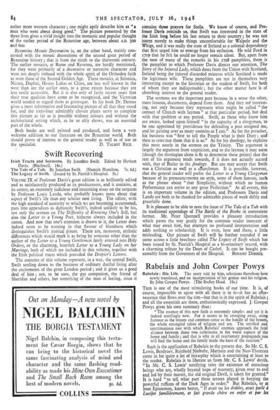Swift Recovering
Irish Tracts and Sermons. By Jonaligur swift. Edited by Herbert Davis. (Blackwell. 14s.)
VOLUME IX of Professor Davis's great edition is as brilliantly edited and as satisfactorily produced as its predecessors, and it contains, at its centre, an extremely judicious and interesting essay on the sertnons by Professor Louis Landa, who probably knows more about that aspect of Swift's life than any scholar now living. The editor, with the high standard of austerity to which we are becoming accustomed, puts into appendices as dubiously Swift's, indeed unlikely to be his, not only the sermon on The Difficulty of Knowing One's Self, but also the Letter to a Young Poet, hitherto always included in the canon. And now that one's attention is drawn to it, the Letter does indeed seem to be wanting in that flavour of blandness which distinguishes Swift's ironical pieces. There are, moreover, stylistic differences which would mark it as being -by someone other than the author of the Letter to a Young Gentlemcn lately entered into Holy Orders, or the charming, heartfelt Letter to a Young Lady on her Marriage, both of which are included in this volume, together with the Irish political tracts which preceded the Drapier's Letters.
The contents of this volume represent, in a way, the central Swift, Swift settling down to the business of ordinary dutiful living after the excitements of the great London period ; and it gives us a good deal of him ; not, to be sure the gay companion, the friend of Sheridan and others, but something of the man of. feeling, since it
contains three prayers for Stella. We know of course, and Pro- fessor Davis reminds us, that Swift was interested in the state of the Irish long before his last return to their country ; he was not intent merely to make things uncomfortable for Walpole and the Whigs, and it was really the state of Ireland as a colonial dependency that first urged him to emerge from his seclusion. He told Ford in 1719 that he felt he could no longer remain silent. But, apart from the tone of many of the remarks in his 1708 pamphlets, there is the pamphlet to which Professor Davis directs our attention, The Story of the Injured Lady, which dates from the Union with Scotland, Ireland being the injured discarded mistress while Scotland is made the legitimate wife. These pamphlets are not in themselves very interesting except to the historian or the student of Swift, for both of whom they are indispensable ; but the other matter here is of absorbing interest to the general reader.
The sermons are the important part because in a sense the other, more famous documents, depend from them. And they are' interest- ing, not only because they represent what might be called "the contact of Church with layman" at that particular period, but deal with that problem at any period. Swift, as those who know, him are aware, looked upon himself "in the capacity of a clergyman, to be one appointed by providence for defending a post assigned me, and for gaining over as many enemies as I can." As for the preacher, his business was "first to tell the People what is their Duty ; and then to convince them that it is so." As for his theology, he explains this most nearly in the sermon on the Trinity. The argument is largely the argument from scepticism, and to the layman it may seem (though the theologian alone is fit to determine these points) that the rest of his argument tends towards, if it does not actually accord with, that of Butler in the Analogy. But one may accept that Swift was a Christian as well as a churchman. It is possible. however, that the general reader will prefer the Letter to a Young 'Clergyman because of its pronouncements on style, some of them famous, such as the phrase about "that Simplicity, without which no human Performance can arrive to any great Perfection." At all events, this is an important volume in the edition, and Professors Davis and Landa are both to be thanked for admirable pieces of work deftly and gracefully done.
It is pleasant to be able to note the issue of The Tale of a Tub with its traditional appendage of The Battle of the Books in convenient format. Mr. Peter Quennell provides a pleasant introduction which paves the way gently for the common reader innocent of what may await him, but attempts no profound interpretation and adds nothing to scholarship. It is even here and there, a little misleading. Our picture of Swift will even, further rounded if we come across a little brochure called The Legacy of Swift which has been issued by St. Patrick's Hospital as a bi-centenary record, with a charming tribute by the Dean of Cashel. It can be bought pre- sumably from the Governors of the Hospital. BONAMY DOBREE.


































 Previous page
Previous page